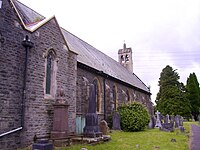Hopkinstown
Hopkinstown
|
|
|---|---|
 Saint David's Church, Hopkinstown |
|
| Hopkinstown shown within Rhondda Cynon Taf | |
| OS grid reference | ST060904 |
| Principal area | |
| Ceremonial county | |
| Country | Wales |
| Sovereign state | United Kingdom |
| Post town | PONTYPRIDD |
| Postcode district | CF37 |
| Dialling code | 01443 |
| Police | South Wales |
| Fire | South Wales |
| Ambulance | Welsh |
| EU Parliament | Wales |
| UK Parliament | |
| Welsh Assembly | |
Hopkinstown (Welsh: Trehopcyn) is a small village to the west of Pontypridd town centre in the county borough of Rhondda Cynon Taf, Wales situated alongside the banks of the River Rhondda. Hopkinstown is a former coal mining industrial community and is a district in the town of Pontypridd within the Rhondda electoral ward. It is neighboured by the settlements of Pwllgwaun, Trehafod and Pantygraigwen, and also comprises the subdistricts of Troed-Rhiw-Trwyn and Gyfeillion.
The area where Hopkinstown is located was, as late as 1842, an undeveloped woodland known as the Ty Mawr Estate. Owned by Evan Hopkin, the area developed quickly soon after, until around 1850 it was beginning to develop into an urbanised development following the sinking of two collieries, Ty Mawr and Gyfeillion pits. Along with buildings to house the miners, Hopkinstown quickly acquired a chemical works, iron foundry and coke ovens.
The original village was a single row of houses along the Rhondda Road which followed the River Rhondda, but it wasn't until the 1871 census that the name Hopkin's Town was used to describe the area. By 1891 the village had a population of over 1,500 and several streets of terraced houses had been built.
Hopkinstown would see eight shafts sunk during the industrial period. John Calvert, an engineer from Yorkshire, who had already sunk the Newbridge Colliery (later to become part of the Maritime Collieries, near Graig, Pontypridd), and in 1848 his money allowed the construction of the Gyfeillon Colliery, it would change hands to the Great Western Railway company, before reverting to Calvert before he sold into to the Great Western Colliery Company. The company would sink six shafts in total and the pits would collectively be known as the Great Western Collieries.
Two other mines in the area, not owned by the Great Western, were the Typica Pit at Troed-rhiw-trwyn, which was only open for five years between 1875 and 1879, and the Lan Colliery, the only pit in Hopkinstown south of the River Rhondda. In 1889 it was owned by William Davies of Pontypridd, employing only seven miners; the mine closed in September 1907.
On Tuesday 11 April 1893 there was a fire in the Great Western Mine colliery which resulted in some 200 miners being trapped underground. Although the majority were rescued the eventual death-toll was 63 men and boys.
...
Wikipedia

